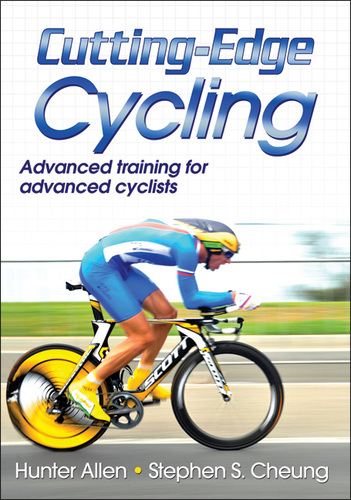
When appraising any piece of research it helps to be aware of potential biases, so before I review Cutting-Edge Cycling
perhaps I should declare that Hunter Allen has been a significant influence on my approach to cycle training and in turn to cycle coaching. His book, Training and Racing with a Power Meter
, co-written with Dr Andrew Coggan, opened up the world of power based training to me; even now, with far more information freely available, that book remains a reference. Having already had such impact on my training, I was eager to read Hunter Allen’s and Stephen Cheung’s take on the cutting-edge of cycling.
Before they begin this broad review of the science of cycling Allen and Cheung take great care to ensure readers understand how scientific research should be evaluated. For all the benefits of evidence-based training the opening chapter heavily emphasises the important of critical thinking both in the interpretation of results and their practical application. The evidence for altitude training may suggest benefits from living high, training low, but for the 40 percent who are nonresponders it makes no difference; before we decide to buy a hypoxic tent, it’s worth examining whether we will gain. Or consider the arguments for and against antioxidant supplementation – free radicals are bad, training produces free radicals, so we should supplement; but further research suggests free radicals help stimulate adaptation, perhaps we shouldn’t supplement? Scientific opinion changes with new evidence, research may have limitations and analysis may hide distinct outliers. Central to Cutting-Edge Cycling is the idea that science can guide us, but we need to weigh the evidence and choose the approach that will work for us.
Warned of the dangers of bad science, the initial chapters focus on the fundamentals of cycle training – what we can train, how we can train and how we can measure it. There is inevitably some crossover with Training and Racing with a Power Meter, but where that is an in depth guide to training with power, Cutting-Edge Cycling sticks to its remit and presents the information in a broader context. For those familiar with Allen’s previous work little is new, but if you are unfamiliar with power, concepts are clearly introduced and carefully explained in a way likely to prompt further research. At the very least these two chapters ensure every reader has an adequate understanding of the basics of cycle training; enough to venture into the broader topics of subsequent chapters.
This is where Cutting-Edge Cycling comes into its own, the subject matter of later chapters – periodisation, pacing, overtraining, bike fit, pedalling technique, hydration and supplements, and environmental conditions – is of far more interest. Each topic is clearly presented with a selection of references and commentary on its implications for cyclists. The tone remains neutral, Allen and Cheung stick to the facts and avoid speculation; while I appreciate this even-handed review, occasionally it frustrates and I want to know their personal views. Does Allen ever coach pedalling technique or cadence? I’ve read the evidence provided, but I wonder how he interprets it and applies it to training; I promise to still apply my own critical thinking.
A scientific review could very easily be dry, but with an emphasis on making research accessible the approach is practical and doesn’t get bogged down. Throughout interviews with experts providing a broader insight into the world of sports science and how experts in the field apply the results of their own research. It’s a nice touch and one that helps ground Cutting-Edge Cycling in the real world. But we shouldn’t be surprised that the creators of the various bike fitting systems outlined in chapter 7 each thinks theirs is the best; again it is up to the reader to apply critical thinking and decide.
Attempting to cover so many topics in 250 pages inevitably comes at the cost of depth and at times I wanted to know more. Particularly on the topic of supplements – Allen and Cheung offer a few examples of the particular dangers within supplement research and its interpretation, before pointing the reader to other sources (the Australian Institute of Sport website gives a useful summary). I accept that the field is too complex to adequately cover in this book and that content could become rapidly outdated (a danger with any piece of research), but a more detailed examination of a small selection of popular supplements would have been a useful starting point. This one is definitely left in the reader’s hands.
True, much of this information is available on the internet, but Cutting-Edge Cycling provides an easily accessible overview of the most recent research and its implications for how we train. While I consider myself well read and have researched many of the topics featured, there was still something new to learn; for those less familiar with the application of sport science in cycling this is a perfect introduction.
My copy of Cutting-Edge Cycling by Hunter Allen and Stephen Cheung was kindly provided in eBook format by the publisher Human Kinetics.
